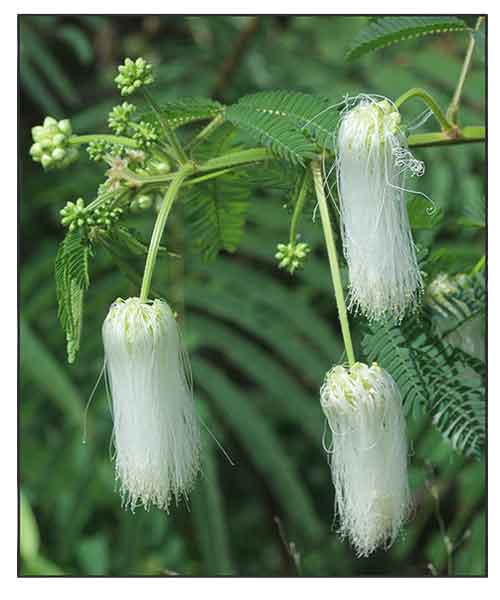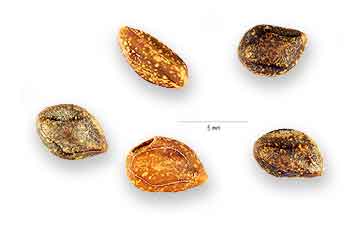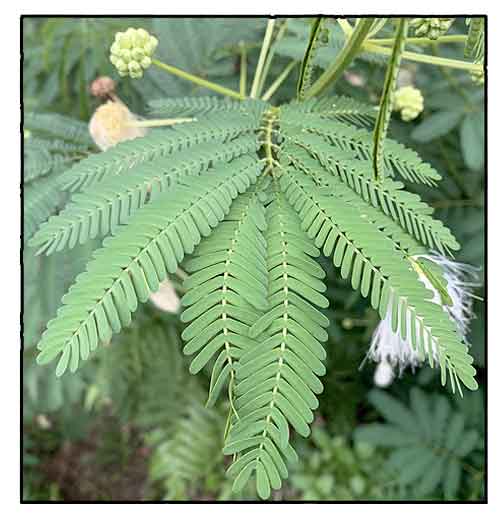 Gen info Gen info
- Zapoteca is a genus of flowering plants in the family Fabaceae, in the mimosaid clade of the subfamily Caesalpinioideae. It was separated from the genus Calliandra in 1986 on the basis of chromosome numbers. (3)
- Etymology: The genus name Zapoteca honors the Zapotec peoples.
Botany
• Mimosa portoricensis is a small shrubby plant that grows up to 2 feet tall and bears compound leaves that are bipinnate, meaning they have two rows of small, rounded leaflets on either side of a central stem. Leaflets are small, wavy, and covered with fine hairs. Flowers of Mimosa portoricensis are small and pink, borne in spherical clusters that emerge from the leaf axils. Fruit is a small pod filled with seeds that rattle when ripe. (Botanniks)
• Stems - Woody, erect or ascending, branches curved, spreading or stooped, firm, old branches glabrous or slightly hairy, young branches rarely to densely hairy. Leaves - Compound, leaf blade 10-30 pairs, linear or linear-oval, straight or slightly curved, 8-16 mm long, 2.5 mm wide or less, slightly veined, blunt, thin. Flowers - Slender stalks clustered or solitary, 3-10 cm long, petals 2 mm long, crown 3-4 mm long, white stamens, 1.5-2 cm long. Fruits - Pods 4-10 cm long, 6-9 mm wide, hairless when mature, obtuse, narrowing towards the base, contains 3-10 seeds. Seeds - Seeds with elliptical lines or depressions, pleurogram, ovate to rounded, seed surface smooth, brown, or black. (SOCFINDO Conservation)
Distribution
- Naturalized. (1)
- Ornamental cultivation.
- Native to Argentina Northeast, Belize, Bolivia, Brazil North, Brazil Northeast, Brazil West-Central, Colombia, Costa Rica, Dominican Republic, Ecuador, El Salvador, Guatemala, Guyana, Haiti, Honduras, Jamaica, Leeward Is., Mexico Gulf, Mexico Northwest, Mexico Southeast, Mexico Southwest, Nicaragua, Panamá, Peru, Puerto Rico, Venezuela, Venezuelan Antilles, Windward Is. (2)
 Constituents Constituents
- Phytochemical analysis of aqueous and ethanol extracts of leaves yielded alkaloids, tannins, saponins, flavonoids, anthraquinones, terpenoids, and cardiac glycosides.
- Phytochemical analysis of water, methanol, ethyl acetate and diethyl ether extracts of leaves revealed alkaloids, flavonoids, saponins, tannins, cardiac glycosides, terpenoids, and anthraquinones, which varied significantly (p<0.05) among the extracts. Vitamin levels of B2, B6, C, E, and niacin, along with K, Mg, P, Zn, and Fe, found in all extracts, did not show significant difference in values (p>0.05). (see study below) (8)
- Phytochemical screening of freshly dried roots yielded alkaloids, terpenoids, glycosides, and flavonoids. (see study below) (10)
- Study of methanol root extract of Z. portoricensis isolated two dipeptides, saropeptate (aurantiamide acetate) and anabelamide. (see study below) (11)
 - Proximate analysis showed presence of tannins, flavonoids, alkaloids, saponins, HCN, terpenoids, steroids, phenols, glycosides, reducing sugars, and soluble carbohydrates
in the crude methanol extract, methanol and ethyl acetate fractions while reducing sugars and soluble carbohydrates were not detected in EAF. FTIR studies revealed presence of OH, NH, C-OH, C-C, C-N, C-H, and C=C in the CME, MF, and EAF. (see study below) (15) - Proximate analysis showed presence of tannins, flavonoids, alkaloids, saponins, HCN, terpenoids, steroids, phenols, glycosides, reducing sugars, and soluble carbohydrates
in the crude methanol extract, methanol and ethyl acetate fractions while reducing sugars and soluble carbohydrates were not detected in EAF. FTIR studies revealed presence of OH, NH, C-OH, C-C, C-N, C-H, and C=C in the CME, MF, and EAF. (see study below) (15)
- GC-MS analysis of ethyl acetate extract of roots revealed presence of 62 compounds which includes n-Hexadecanoic acid (RT 14.81, Area % 10.03), 9,12-Octadecadienoic acid (Z,Z)- (RT 15.97, Area % 10.03), cis-9-Hexadecenal (RT 16.01, Area % 8.36). (see study below) (16)
- Study showed stem bark as a source of antioxidants. The ethyl acetate fraction of Zp stem showed high phenolic content (131.76 mg GAE/g) and high flavonoid content (433.33 mg QE/g). The n-hexane fraction showed most flavonoids (963.33).
(see study below) (20)
Properties
- Studies have suggested antioxidant, antibacterial, hepatoprotective, neuroprotective, cognitive-improving, antimicrobial, immunomodulatory, antiulcer, trypanocidal, anti-BPH, cholinesterase inhibitory, anticonvulsant, anti-trypanosomal, antibiofilm properties.
 Parts used Parts used
Leaves, roots.
Uses
Edibility
- No reports found on edibility.
Folkloric
- No reported folkloric medicinal use in the Philippines.
- In the eastern part of Nigeria, the shoot system is used by traditional healers for treatment of convulsions, constipation, madness, external wounds, skin infections, among others. (5) Used for treatment of tonsillitis, fever, breast engorgement, stomach disorders, amenorrhea, and as purgative. (6)
- In Nigeria, Calliandra portoricensis is traditionally used to treat tuberculosis, as anthelmintic and abortifacient.
Studies
• Antioxidant / Hepatoprotective / Leaves: Study of evaluated the antioxidant and hepatoprotective properties of distilled water and ethanol leaf extracts in albino rats. Carbon tetrachloride (CCl4) was given intraperitoneally. Pretreatment of rats with extracts produced significant decrease (p<0.05) in ALT, AST, GGT, and MDA, with significant increase (p<0.05) in SOD and CAT activities. Results were dose-dependent, suggesting hepatoprotective and antioxidant potentials. (see constituents above) (5)
• Antibacterial / Hepatoprotective / Roots: Study evaluated the antibacterial properties of roots extract of Z. portoricensis. Of solvents used, only the ethanol fraction of crude extract was active against both gram-negative and gram-positive bacteria viz., Streptococcus pyogenes, Escherichia coli, Salmonella typhi, Klesiella pneumonia, and Bacillus subtilis. Results showed significant ZOIs and MICs ranging from 6.25 to 25 mg/ml. (see constituents above) (6)
• Neuroprotective / Scopolamine-Induced Alzheimer's Disease Model / Roots: Alzheimer's disease is characterized by memory loss related to central cholinergic system dysfunction. Study evaluated the neuroprotective effect of Z. portoricensis root extract on scopolamine-induced dementia in Swiss albino rats pretreated with donepezil (mg/kg p.o) or extract (100, 200, 400 mg/kg po) for 14 days. Scopolamine significantly (p<0.01) increased concentration of acetylcholinesterase enzyme (AChE) in scopolamine-only treated rats. Administration of extract and donepezil significantly (p<0.01) increased levels of catalase, superoxide dismutase, reduced glutathione and significantly increased malondialdehyde. Results suggest the root has neuroprotective effect and can improve cognitive functions. (7)
• Antimicrobial / Leaves: Study evaluated the phytochemical contents and antimicrobial properties of leaves of Z. portoricensis using agar disc diffusion. Extracts inhibited all microorganisms tested in a concentration dependent manner, the water extract showing significantly higher activity (p<0.05) than other organic extracts. (see constituents above) (8)
• Immunomodulatory / Roots: Study evaluated the immunomodulatory activity of methanol root extract and fractions of Z. portoricensis using three experimental models: neutrophil adhesion, hemagglutination antibody (HA) titer and delayed hypersensitivity (DTH) of immune response in mice. Results showed the methanol extract exhibited highest % (46.12%) in neutrophil adhesion at 100 mg/kg dose. Percentage increase in both primary and secondary antibody titer were 85.19% and 43.20% for methanol extract==, 91.53 and 102.67% for ethyl acetate fraction, and 128.31 and 111.89% for methanol fraction. The EF at 25 and 50 mg/kg showed highest % inhibition (56.57% and 58.33%) in DTH response. Results showed Z. portoricensis exhibited immunomodulatory effects on specific components of the immune system in mice. (9)
• Antiulcer / Roots: Study evaluated the antiulcer activity of Z. portoricensis roots in experimental rats using absolute ethanol and indomethacin induced ulcer models in male albino rats. Sucralfate (100 mg/kg p.o.) as reference drug and extract doses of 50, 100, and 200 mg/kg. Inhibition of ulcer (51.1%, 65.7%, and 80.0%) was observed with treatments in a dose dependent manner. Results suggest the roots possess potent antiulcer property. (10)
• Trypanocidal Dipeptides / Roots: Study of methanol root extract of Z. portoricensis isolated two dipeptides, saropeptate (aurantiamide acetate) and anabelamide. Evaluation for trypanocidal activity showed compound 1 exhibited potent activity against Trypanosoma brucei rhodesiense with IC50 of 3.63 µM and selectivity index of 25.3. (11)
• Effect in Benign Prostatic Hyperplasia / Roots: Study evaluated the effect of crude methanol extract (CME) of Zapotec portoricensis root and methanol (MF) and ethyl acetate (EA) fractions in management of benign prostatic hyperplasia (BPH). BPH was induced by dihydrotestosterone and estradiol. One group was treated with dutasteride. Treatment groups were treated with 200 and 400 mg/kbw of CME and fractions. At 400 mg/kbw p.o. by gavage, CME, MF, and EAF decreased PSA (prostatic specific antigen) by 55.91, 57.54 and 56.75%, respectively, comparable to 58.80% by dutasteride. Extracts restored BPH-modified hematological and biochemical status of extract treated rats. Results suggest root extracts normalized aberrations associated with BPH and may justify the plant's folkloric use in the management of BPH. (12)
• Anticonvulsant / Roots: Study evaluated the anticonvulsant activity of root extract and fractions of Zapotecca portoricensis in mice using three in-vivo test models: pentylenetetrazole (PTZ), picrotoxin (PTX), and strychnine (STR) induced convulsions in mice. Test groups received extract and fractions doses of 100, 200, and 400 mg/kg p.o. The root extract and fractions dose dependently exhibited significant anticonvulsant activity. (13)
• Wound Healing / Antioxidant / Leaves: Study evaluated the wound healing and antioxidant potentials of aqueous and ethanol extracts of fresh leaves of Zapoteca portoricensis in albino rats. Serum levels of total protein, proteinases and vitamin C were used to assess wound healing property, while malondialdehyde (MDA), superoxide dismutase (SOD), catalase (CAT) and glutathione reductase (GR) were measured for antioxidant activity. Proteinases activity and vitamin C concentration were significantly higher (p<0.05), while MDA was significantly decreased (p<0.05). Findings suggest fresh leaves may be useful for treatment of wounds due to antioxidant potential. (14)
• Phytochemical and Phytochemical Composition / Toxicity Studies / Roots: No mortality and behavioral changes were observed in test animals up to 5,000 mg/kbw in toxicity studies. Results suggest safety of the plant root to its users. (see constituents above) (15)
• Cholinesterase Inhibitory / Antioxidant / Roots: Alzheimer's disease is typified by the unavoidable decline in cognitive function. Study evaluated the cholinesterase inhibitory and antioxidant potentials of Z. portoricensis root extracts. The ethyl acetate extract showed the highest acetylcholinesrterase and butyrylcholinesterase inhibitory potentials with IC50s of 0.149 mg/mL and 0.393 mg/ml respectively compared to eserine for AChE and BuChE IC50s of 0.051 and 0.049 mg/mL respectively. The ethyl acetate extract showed highest total antioxidant potential. The ethyl acetate root extract has the potential to prolong the half-life of acetylcholine by its ability to inhibit cholinesterase enzyme. (see constituents above) (16)
• Antimicrobial / Root Extract Lozenges: Study formulated Z. portoricensis root extract as lozenges and evaluated their antimicrobial and tablet properties using (A) Sodium Carboxyl Methyl Cellulose (SCMC), (B) Carboxy Methyl Cellulose (CMC) as binders, and reference standard Dequadin® containing dequalinium HCl (C). Evaluated measures were uniformity of weight, crushing strength, microbial sensitivity and pre-extinction time studies (using E. coli, S. aureus, and C. albicans). S. aureus and Candida albicans were sensitive to the test lozenges, E.coli was not. C. albicans was minimally sensitive to standard lozenge, S. aureus was not. Both test and standard samples showed extinction times greater than 30 min. (17)
• Bokkosin / Antiparasitic / Cytotoxic / Roots: Phytochemical fractionation and screening of root extracts yielded bokkosin, a novel (5-hydroxy-7-methoxy-4-oxo-1-chromanyl)-4-methoxy-p-benzo-quinone (breverin)-substituted cassane diterpene. Study showed promising antiparasitic activity against Trypanosoma brucei brucei, as well as moderate activity against Trypanosoma congolense and Leishmania mexicana and low toxicity in mammalian cells. It showed best in-vitro EC50 against T. b. brucei. Study suggests bokkosin is a potential trypanocide and should be tested for other micro-organisms as well. (18)
• Modulation of Oxidative Stress In Experimental BPOH / Roots: Study evaluated the effect of crude methanol extract (CME) of Z. portoricensis root and methanol (MF) and ethyl acetate (EAF) fractions on the pro-oxidant/antioxidant status of experimentally-induced BPH in Wistar albino rats. At 400 mg/kbw, the CME, MF and EAF decreased PSA by 55.91, 57.54, and 56.75%, respectively, compared to 58.80% by dutesteride. Histological assessment showed improved prostate status. Results suggest the extracts returned the pro-oxidant/antioxidant status modified by BPH to normal. Results justify the plant's folkloric use and suggests exploitation for constituents for management of BPH. (19)
• Antioxidant / Stem: Study evaluated Z. portoricensis stem's ethanol extract and fractions (n-hexane, ethyl acetate, n-butanol) for total phenolic and flavonoid content and antioxidant potential. Results showed stem bark as a source of antioxidants. The ethyl acetate fraction of Zp stem showed high phenolic content (131.76 mg GAE/g) and high flavonoid content (433.33 mg QE/g). The n-hexane fraction showed most flavonoids (963.33). Results suggest Zp as a rich source of antioxidants and potential for development of useful food supplements and health remedies. (20)
• Antioxidant / Antibacterial / Antibiofilm / Roots: Study evaluated the phytochemical composition, antioxidant, antibacterial, and antibiofilm activities of ethanol extract of Zp roots. The extract exhibited concentration dependent antioxidant values in DPPH and FRAP assays. At 62.5 mg/ml, the root extract exhibited antibacterial activity against E. coli and S. aureus, with ZOIs significantly lower than S. typhi. MICs against E. coli, S. aureus and S. typhi were 31.25, 15.63, and 62.50 mg/ml. Extract showed concentration-dependent increase in antibiofilm activity, with 28.87, 34.01, and 66.45% inhibition against S. typhi, E. coli, and S. aureus, respectively. The antioxidant, antibacterial, and antibiofilm activities may be linked to the presence of ethyl iso allocholate and hexadecanoic acid. (21)
Availability
- Wild-crafted. |

![]()







